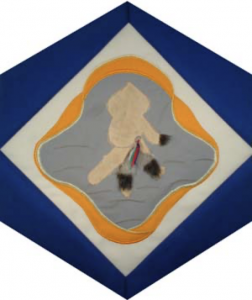Qikiqtani

The Block
The Qikiqtani block, designed and stitched by Monica Ell, shows an Inuit woman rushing over the expanses of Arctic ice, amauti tail blowing in the breeze. She hurries, knowing that there is so much to do when taking care of a family. The centre of the block is made solely of sealskin, using a scraped tanned hide to depict the distinctive, hooded parka; the women’s garment features extra room on the back to cover a baby, or small child, strapped to the mother by a special sash worn underneath and tied at the waist. Two colours of sealskin create the woman’s protective pants, mitts and boots. Golden yellow on the horizon represents the northern sun.
Cultural Profile
The Qikiqtani Inuit live in Qikiqtaaluk (formerly Baffin Island), one of the three regions of Nunavut, Canada’s newest territory formed on April 1, 1999. Inuktitut is the common language spoken by the Inuit in all of Nunavut. In Inuktitut Inuit means “the people who are alive at this time”. Their land is mostly tundra and the area is typically frozen and snow-covered for more than half the year. Temperatures can range from -40º F in the winter to 5º F in the summer.
Inuit lived in the Nunavut region for thousands of years before the first European explorers arrived searching for whales and a passage through Arctic waters (eventually establishing the Northwest Passage). Anthropologists rarely find evidence of Inuits’ long history because the people generally lived on ice, so many artifacts were lost to summer thaws. Although there are rich deposits of copper, lead, silver, and zinc in the region, the harsh climate and lack of infrastructure make development of these resources difficult.
Inuit were once nomadic people who followed the caribou, seals, walrus, whales, cod, char and salmon, which were vital sources of food, and provided materials for clothing and tools. To hunt sea mammals (whales, seals and walrus), the Inuit used a harpoon consisting of a blade made of bone, stone, or in later times, iron, a harpoon head and foreshaft of ivory or antler, a long shaft and a sturdy line. Summer travel was either overland, on foot, or on the water in kayaks and the larger, open umiak (that could carry about 20 people). Winter transportation necessitated the use of a kamotiq, a large sled pulled by a dog team. Today, most Inuit live in small communities and depend on trapping and mining for their livelihood.
Sponsor: Robert & Janice McGillis
